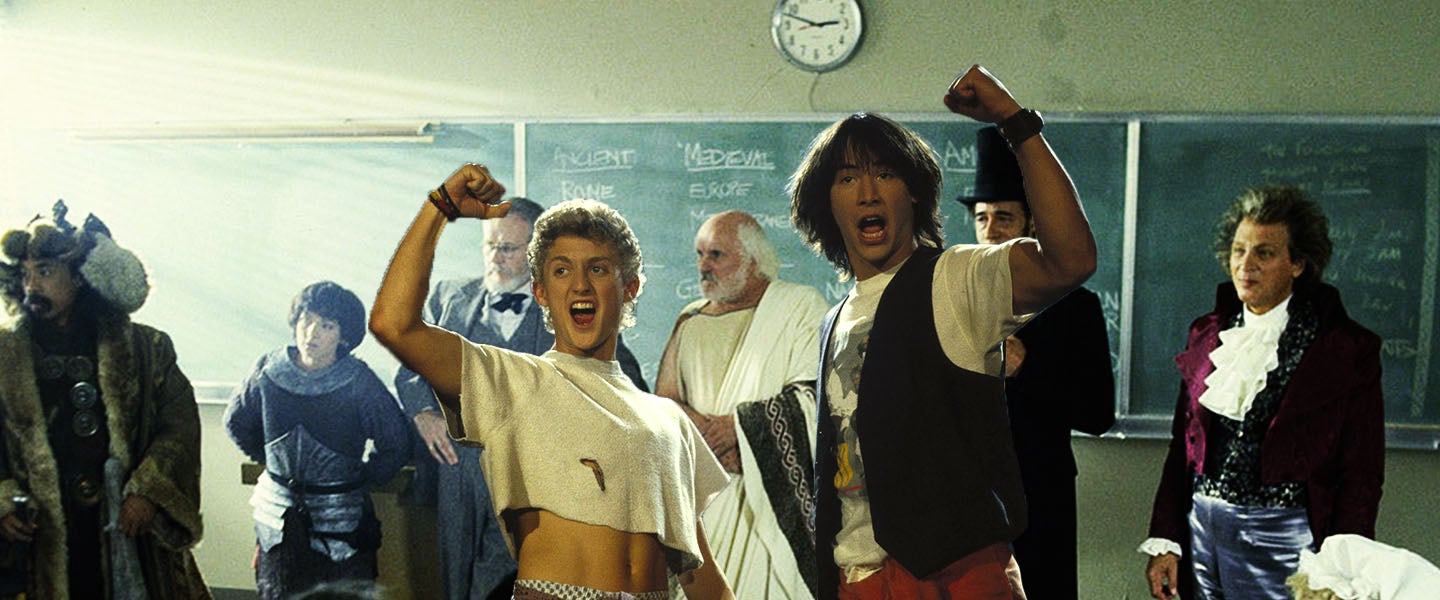In 2004, Jamie was finishing up her first year as a high school history teacher. There were several days left in her world history course, and she had already completed the curriculum. “I was like, what am I going to do with these kids with two days left of school?” says Jamie (who asked to be identified by first name only because she currently teaches at a rather conservative district). “I know — I’ll show a historic movie.”
If you search “historic movies” on Google, the top results tend to be stuffy biopics or Oscar-nominated war films: Lincoln, Dunkirk, Darkest Hour, Hacksaw Ridge. Jamie showed her freshman students nothing of the sort.
She chose Bill & Ted’s Excellent Adventure, the bodacious 1989 comedy about two teenage boneheads who travel through time, kidnap historical figures like Napoleon and Abraham Lincoln and transport them to present-day California in order to pass a final project in their own history class.
Thirty years after its release, Bill & Ted has unexpectedly found new life among the very people caricatured in the film as stodgy-minded squares: history teachers.
In fact, educators have embraced the film far more than critics ever did. In classrooms around the country, students are discovering the past through the most triumphant eyes of two Van Halen–loving valley dudes who think Socrates is pronounced “SOH-crates” and believe Joan of Arc to be “Noah’s wife.”
Students are watching "Bill and ted's Excellent Adventure" and I am packing up my classroom. Win win situation!
— Jenny G Traweek (@JennyTheSpaz) May 25, 2010
It is both a quintessentially ’80s cult classic and an utterly ridiculous movie, made more so by the performances of a young Alex Winter and pre-fame Keanu Reeves as the ragingly hormonal teens who worship Iron Maiden and attempt to bone medieval princesses in 14th-century England.
How can such a ridiculous movie possibly be deemed educational?
“I was just looking for any history movie to show,” Jamie says. But her students loved it. “Then I was like, there’s actually potential to use this meaningfully in class.”
For the last 15 years, Jamie has been showing the film as a planned activity during the first week of school. Later on in the year, “they have to write a modern Bill & Ted script: ‘Okay, you’re going back in time; who are you bringing back and why?’ Instead of taking a test, because tests are boring.” Sometimes, Jamie even has the students act out their time-travel scripts. And she is not the only teacher using this VHS-era absurdity as a classroom tool.
“People think history is a really dry subject,” says Leslie Richey, who teaches AP-level history at a Texas high school. “I try to tell them history is sex, drugs and rock & roll. [The film] is a really good way to show it.”
Richey likes to show the film toward the end of the year in her AP World History course. But her favorite memory is when she showed it during an all-night review session for the AP exam, which she held at a church. “I showed Bill & Ted as a break. Everyone lay on a floor, and we projected this movie. I was able to bring in the different periods of history because of the different characters in it. That’s a historical thinking tool called synthesis, where you take elements and connect them across different historical periods.”
When I started teaching history I used this film all the time. I had my senior students create a Bill and Ted adventure for their final. In order to do this they had to have deep understanding and humour. Loved reading them. Thanks!
— Jennifer Cordon (@jenfarrellcordo) February 14, 2018
“When I show The Patriot, it’s so serious,” says Jenny Traweek, a seventh grade U.S. history teacher whose passion for the subject is so intense she named her children after early American presidents. “And National Treasure — there’s really no value to it. I like how [Bill & Ted] blends world history with American history… [And] it makes it funny. Like, they can’t find Napoleon and he’s at the Waterloo water park. It makes them laugh. Which makes them appreciate history just a little bit more.”
Traweek first got the idea to show Bill & Ted because her own teacher had used it when she was in high school in the early 2000s. Her students are a bit younger. “The only scene I have to monitor when showing it to middle school students is when Napoleon is bowling and he starts cussing,” she says now. “Although he says it in French, I go and block the subtitles at the bottom.”
Unlike Forrest Gump — or the Hamilton soundtrack, which has become wildly popular among nerdy pop culture-loving history teachers in recent years — Bill & Ted condenses many centuries of historical content into a relatively short runtime. And it’s an obvious choice for teachers who grew up in the late ’80s or ’90s and are now likely to view the film as a generational classic.
The film’s message is essentially pro-academic: By learning history and passing their class, Bill and Ted are able to inspire a utopian society through the music of their band, Wyld Stallyns. (Despite this futuristic bent, the film’s musical references are hilariously dated — Bill and Ted cite Bon Jovi’s Slippery When Wet as a touchstone and fantasize about Eddie Van Halen joining their band. For Gen-Z students, this era must seem about as distant as the Napoleonic Wars of the early 1800s.)
Some teachers have embraced the film more for its moral message than its historical content. That’s the case with Joe Ruiz, who teaches business classes at a high school in Indiana and also raps under the name Rhymer/Educator. “I’ve made my banner rule in class ‘Be excellent to each other,’” Ruiz says, citing Bill and Ted’s favorite slogan. “I took that directly from the movie because I think it encompasses all sorts of things: Don’t hurt people, don’t take their stuff, be decent to each other.” This rule appears on his syllabus and several posters around Ruiz’s classroom, which call it “the Bill & Ted rule” in parentheses. Sometimes Ruiz shows his students the film when there’s a free day before a vacation.
“There’s a lot of quotes from the movie I tend to use in random conversation,” Ruiz says. “Like with Socrates: ‘The only true knowledge exists in knowing that you know nothing.’ I find that coming out of my mouth quite a bit. It just kind of makes sense.”
Richey also likes the film’s core message: “The point of the whole world is just to be nice to someone else,” she says.
But for many history teachers, the primary appeal of Bill & Ted is the accessible and often silly depictions of major historical figures. Socrates (or “SOH-crates”) appears as a jovial bearded “philosophizer” who delights in the teens’ time-traveling exploits and whose mind is blown by sophomoric stonerisms borrowed from Kansas’ “Dust in the Wind.” Sigmund Freud is portrayed as serious and relentlessly analytical, diagnosing Ted’s troubled relationship with his father. Napoleon is depicted as a petulant and demanding jerk who cheats and then throws a tantrum while bowling.

“Intentionally or unintentionally, it captures the way that Napoleon was caricatured by 19th-century British cartoons — as a power-hungry buffoonish small tyrant,” says Jacob Field, an English historian of the early modern period who teaches at the University of Cambridge. “They got Lincoln pretty well. I think it’s as good a Lincoln as the Daniel Day-Lewis, in a much more concise way. Genghis Khan, looking back, is wrong: The mongols are actually much more sophisticated than these rampaging barbarians.”
One of the film’s best bits is an extended sequence in which the historic icons go nuts at the local mall — Beethoven discovers synthesizers, Joan of Arc takes over an aerobics workout class, Genghis Khan goes apeshit in a sporting goods store. Several teachers particularly raved about this sequence.
“Joan of Arc trained an army,” says Jamie. “So in a modern setting, what would she do? An exercise class! You kind of see how these historical figures would function in today’s society. It’s a good conversation for the kids.” (One year, a student raised their hand and asked Jamie if Napoleon really enjoyed waterslides: “I was like, ‘Okay, well, see, hon…’”)
@alxwinter wanted to let you know that "Be Excellent to Each Other" is Rule #1 in my high school classes. Like, it's actually written in my syllabus. Thought you'd appreciate that. And, just like Bill & Ted, I'm trying to use music to change the world. https://t.co/C3l2YTiPBM
— Rhymer/Educator (@RhymerEducator) June 11, 2018
Field showed clips from this part of the film when he was teaching a course on military history at the University of Waikato in New Zealand. He had been a fan of the film since receiving it as a Christmas present in 1993 and considered it “a really good way to show how our perception of historical figures is skewed.” But students just looked at him blankly. “I think they were too young, and maybe the film didn’t make as much of an impact in New Zealand.”
Erika Sponsler, an AP U.S. history teacher in Michigan, says Bill and Ted’s school presentation is helpful in preparing students for the AP test. “One of the historical thinking skills is ‘Change and Continuity Over Time.’ Bill and Ted’s project is exactly that. They are supposed to be imagining what historical people would think about modern times. Napoleon and his use of waterslides in battle is funny, but Joan of Arc incorporating aerobics into her training plan — that’s a genius idea. This really helps students understand this historical thinking skill because they can actually see the skill in action.”
Sponsler adds: “I also use the football player’s presentation to illustrate what not to do in their essays. When students make a really vague, yet emphatic, statement in their writing, I actually write ‘San Dimas Football!’ on their essay to remind them to be more specific.” (Side note: Sponsler concluded her email to me with the directive “Party on, dude!”)

It should be noted that the film’s sequel, Bill & Ted’s Bogus Journey — in which the titular duo wind up meeting Satan in hell — does not hold the same appeal for educators. (In fairness, it’s also not nearly as good.) Recently, a long-awaited third film, Bill and Ted Face the Music, was revealed to be in pre-production, with confirmed participation from Reeves and Winter.
Maybe that film will eventually materialize for an aging audience hungry for ’80s reboots. But it’s unlikely to achieve the same weird mix of stoner cult appeal and educational resonance as Bill & Ted’s Excellent Adventure. “It’s just one of those feel-good movies,” raves Jamie. “Last time I used it, I tweeted at Alex Winter, and he commented back. So I read it to the class. They were like, ‘Bill’s talking to us!?’ Little things like that mean a lot to the kids.”

